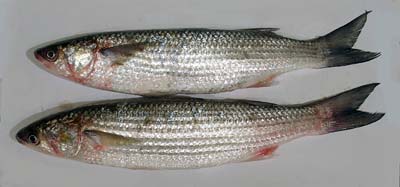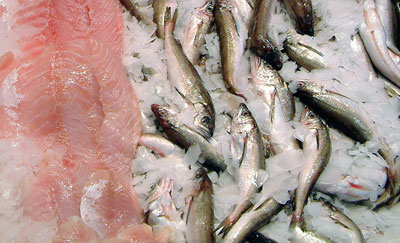
A name in Bermeo for the grey mullet, the commonest and largest of the grey mullet (US: striped mullet) family. It is a silver, shoal-living fish pointed with dark grey which feeds on seaweed and plankton near the muddy bottom in estuaries and coastal waters. This can effect its flavour. However, a good grey mullet, caught in clean water, is round-bodied and has creamy white flesh and good flavour with good keeping capabilities. It must be thoroughly scaled before eating. Varieties are found all over the world. The roe is used for taramasalata, botargo, boutargue.
A name in Bermeo for the twaite shad or gizzard shad from a family of white, migratory fish. The shad is a bony, tasty, oily fish similar to herring, which travels up rivers in spring and is found in deep lakes. In France it is found in the Gironde where it is often grilled over vine shoots or stuffed with sorrel, and in the Loire, where it may be stuffed with beurre blanc. The roe is a great delicacy and shad is also used raw in sushi. Members of the family include Allis shad (Alosa alosa) and the smaller twaite shad or gizzard shad (Alosa fallax).
The flesh of the lower jaw, ganglions that grow in the throat of the hake, greatly prized in the Basque Country, and shaped like an arrow-head. They sound almost like tonsils.

Small hake. A long, slim member of the cod family. Although they can grow up to 1 meter (3 ft) in length, the average size now is about 30-50 cm (12-30 inches). They are found in temperate and cold waters. During the day they lurk on the bottom, but rise in the evenings to hunt for fish such as herring and mackerel. Can also describe salt cod.

Small hake. A long, slim member of the cod family. Although they can grow up to 1 meter (3 ft) in length, the average size now is about 30-50 cm (12-30 inches). They are found in temperate and cold waters. During the day they lurk on the bottom, but rise in the evenings to hunt for fish such as herring and mackerel. Can also describe salt cod.